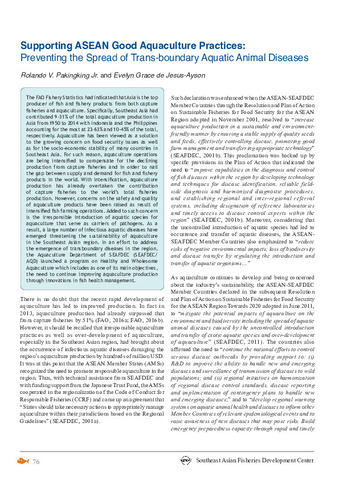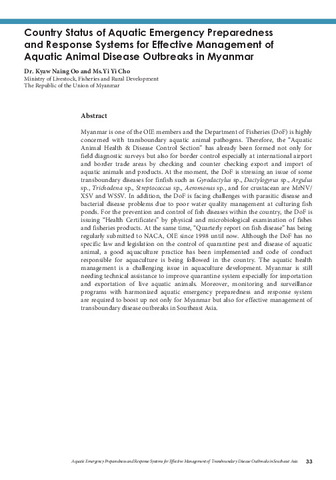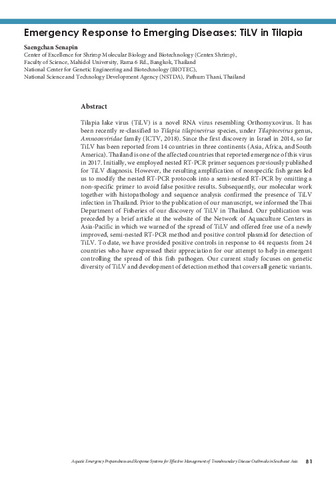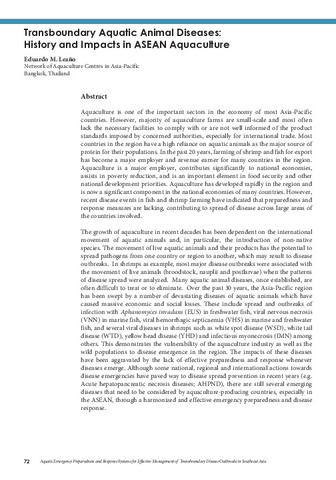| dc.contributor.author | Pakingking Jr., Rolando V. | |
| dc.contributor.author | de Jesus-Ayson, Evelyn Grace | |
| dc.date.accessioned | 2017-11-13T04:28:29Z | |
| dc.date.available | 2017-11-13T04:28:29Z | |
| dc.date.issued | 2016 | |
| dc.identifier.citation | Pakingking Jr., R. V., & de Jesus-Ayson, E. G. (2016). Supporting ASEAN good aquaculture practices: Preventing the spread of trans-boundary aquatic animal diseases. Fish for the People, 14(2), 76-82. | en |
| dc.identifier.issn | 1685-6546 | |
| dc.identifier.uri | http://hdl.handle.net/20.500.12066/985 | |
| dc.description.abstract | The FAO Fishery Statistics had indicated that Asia is the top producer of fish and fishery products from both capture fisheries and aquaculture. Specifically, Southeast Asia had contributed 9-31% of the total aquaculture production in Asia from 1950 to 2014 with Indonesia and the Philippines accounting for the most at 23-63% and 10-45% of the total, respectively. Aquaculture has been viewed as a solution to the growing concern on food security issues as well as for the socio-economic stability of many countries in Southeast Asia. For such reason, aquaculture operations are being intensified to compensate for the declining production from capture fisheries and in order to nail the gap between supply and demand for fish and fishery products in the world. With intensification, aquaculture production has already overtaken the contribution of capture fisheries to the world’s total fisheries production. However, concerns on the safety and quality of aquaculture products have been raised as a result of intensified fish farming operations. Added to such concern is the irresponsible introduction of aquatic species for aquaculture that serve as carriers of pathogens. As a result, a large number of infectious aquatic diseases have emerged threatening the sustainability of aquaculture in the Southeast Asian region. In an effort to address the emergence of transboundary diseases in the region, the Aquaculture Department of SEAFDEC (SEAFDEC/AQD) launched a program on Healthy and Wholesome Aquaculture which includes as one of its main objectives, the need to continue improving aquaculture production through innovations in fish health management. | en |
| dc.language.iso | en | en |
| dc.publisher | Secretariat, Southeast Asian Fisheries Development Center | en |
| dc.subject | Southe East Asia | en |
| dc.title | Supporting ASEAN good aquaculture practices: Preventing the spread of trans-boundary aquatic animal diseases | en |
| dc.type | magazineArticle | en |
| dc.citation.volume | 14 | |
| dc.citation.issue | 2 | |
| dc.citation.spage | 76 | |
| dc.citation.epage | 82 | |
| dc.citation.journalTitle | Fish for the People | en |
| dc.subject.asfa | aquaculture economics | en |
| dc.subject.asfa | socioeconomic aspects | en |
| dc.subject.asfa | infectious diseases | en |
| dc.subject.asfa | fishery management | en |
| dc.subject.asfa | fish diseases | en |
| dc.subject.asfa | husbandry diseases | en |
| dc.subject.asfa | aquaculture statistics | en |
| dc.subject.asfa | disease control | en |
| dc.subject.asfa | aquaculture | en |
| dc.subject.asfa | animal diseases | en |




